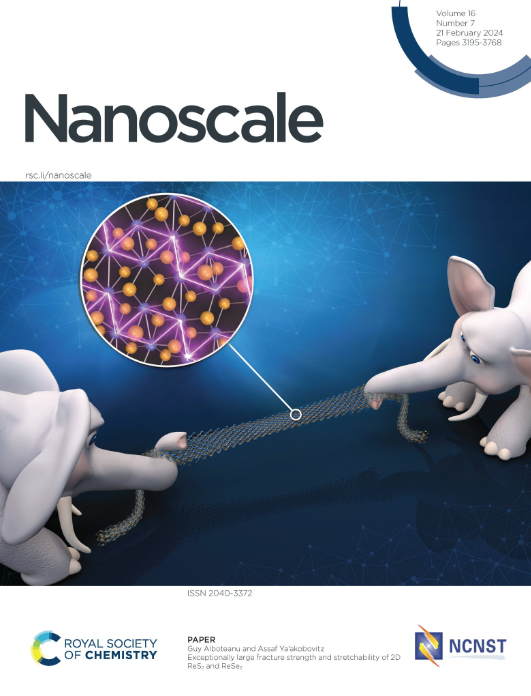Asymmetrical Branched PEG-Modified Liposomes Evade Anti-PEG Antibody Recognition to Abolish Accelerated Blood Clearance and Amplify Tumor Drug Accumulation
IF 5.1
3区 材料科学
Q1 CHEMISTRY, MULTIDISCIPLINARY
引用次数: 0
Abstract
The prevalence of anti-polyethylene glycol (PEG) antibodies poses a significant challenge for the clinical translation of PEGylated liposomes, leading to accelerated blood clearance (ABC) phenomenon and diminishing therapeutic effectiveness. To address this limitation, we designed an asymmetrical branched PEG derivative (mPEG2,5K-DSPE) and prepared mPEG2,5K-DSPE-modified liposomes, which included 1,1'-dioctadecyl-3,3,3,3'-tetramethylindo dicarbocyanine iodide liposomes (P2,5K-DiR) and mitomycin C lipid prodrug (MSC) liposomes (P2,5K-MSC) to minimize the binding of anti-PEG antibodies. Cellular binding assays revealed that the anti-PEG antibodies binding rate for P2,5K-DiR was only 0.91%, significantly lower than that of conventional linear P2K-DiR and P5K-DiR liposomes (99.1% and 79.9%). Pharmacokinetic studies further demonstrated that branched PEG-modified DiR and MSC liposomes effectively eliminated the ABC phenomenon: upon repeated administration, the ABCindex values for P2,5K-DiR and P2,5K-MSC were 0.820 and 1.153, respectively, markedly superior to those of linear mPEG2K-DSPE (0.080 and 0.099) and mPEG5K-DSPE (0.075 and 0.066). In vivo anti-tumor experiments, the tumor growth inhibition rates of P2,5K-DiR and P2,5K-MSC against B16 cells reached 94.6% and 93.89%, respectively, far exceeding those of the linear mPEG2K-DSPE groups (22.47% and 43.8%) and the mPEG5K-DSPE groups (37.8% and 59.17%). More importantly, the tumor inhibition index (TIindex) of the branched PEG groups reached 190.51 and 193.25, while the traditional linear PEG2K groups displayed much lower values (14.53 and 20.2) and the PEG5K group showed TIindex values of 17.98 and 27.46. These findings demonstrate that replacing the conventional linear PEG2K or PEG5K with the branched PEG2,5K can significantly enhance drug accumulation in tumor tissues while avoiding the non-selective systemic damage associated with traditional linear PEG. This study provides an innovative solution to overcome the immunogenicity challenges of PEGylated formulations, highlighting its significant potential for clinical translation.不对称支链聚乙二醇修饰脂质体逃避抗聚乙二醇抗体识别,消除加速血液清除和放大肿瘤药物积累
抗聚乙二醇(PEG)抗体的流行对聚乙二醇脂质体的临床转化提出了重大挑战,导致血液清除(ABC)加速现象和治疗效果下降。为了解决这一问题,我们设计了一种不对称支链PEG衍生物(mPEG2,5K-DSPE),并制备了mPEG2,5K-DSPE修饰的脂质体,包括1,1'-二十二烷基-3,3,3,3'-四甲基二碳氰碘化脂质体(P2,5K-DiR)和丝裂霉素C脂质前药(MSC)脂质体(P2,5K-MSC),以最大限度地减少抗PEG抗体的结合。细胞结合实验显示,P2、5K-DiR的抗peg抗体结合率仅为0.91%,显著低于常规的线性P2K-DiR和P5K-DiR脂质体(99.1%和79.9%)。药代动力学研究进一步表明,支链peg修饰的DiR和MSC脂质体有效消除了ABC现象:反复给药后,P2、5K-DiR和P2、5K-MSC的ABCindex值分别为0.820和1.153,明显优于线性mPEG2K-DSPE(0.080和0.099)和mPEG5K-DSPE(0.075和0.066)。在体内抗肿瘤实验中,P2、5K-DiR和P2、5K-MSC对B16细胞的肿瘤生长抑制率分别达到94.6%和93.89%,远远超过线性mPEG2K-DSPE组(22.47%和43.8%)和mPEG5K-DSPE组(37.8%和59.17%)。更重要的是,支链PEG组的肿瘤抑制指数(TIindex)达到190.51和193.25,而传统的线性PEG2K组的肿瘤抑制指数要低得多,分别为14.53和20.2,PEG5K组的肿瘤抑制指数分别为17.98和27.46。这些研究结果表明,用支链pegg2取代传统的线性PEG2K或PEG5K,5K可以显著增强肿瘤组织中的药物积累,同时避免传统线性PEG相关的非选择性全身损伤。这项研究为克服聚乙二醇化制剂的免疫原性挑战提供了一种创新的解决方案,突出了其在临床转化方面的重大潜力。
本文章由计算机程序翻译,如有差异,请以英文原文为准。
求助全文
约1分钟内获得全文
求助全文
来源期刊

Nanoscale
CHEMISTRY, MULTIDISCIPLINARY-NANOSCIENCE & NANOTECHNOLOGY
CiteScore
12.10
自引率
3.00%
发文量
1628
审稿时长
1.6 months
期刊介绍:
Nanoscale is a high-impact international journal, publishing high-quality research across nanoscience and nanotechnology. Nanoscale publishes a full mix of research articles on experimental and theoretical work, including reviews, communications, and full papers.Highly interdisciplinary, this journal appeals to scientists, researchers and professionals interested in nanoscience and nanotechnology, quantum materials and quantum technology, including the areas of physics, chemistry, biology, medicine, materials, energy/environment, information technology, detection science, healthcare and drug discovery, and electronics.
 求助内容:
求助内容: 应助结果提醒方式:
应助结果提醒方式:


